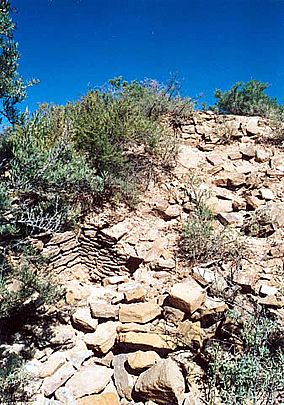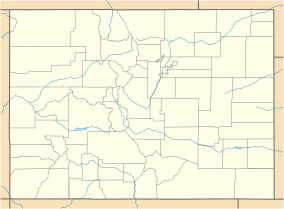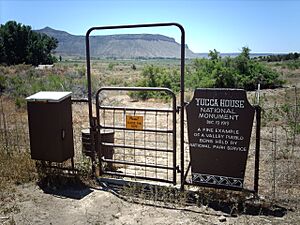Yucca House National Monument facts for kids
Quick facts for kids Yucca House National Monument |
|
|---|---|
|
IUCN Category III (Natural Monument)
|
|

Unexcavated mound at Yucca House National Monument
|
|
| Location | Montezuma County, Colorado, USA |
| Nearest city | Cortez, Colorado |
| Area | 33.87 acres (13.71 ha) |
| Created | December 19, 1919 |
| Governing body | National Park Service |
| Website | Yucca House National Monument |
Yucca House National Monument is a special place in Montezuma County, Colorado, USA. It's located between the towns of Towaoc and Cortez, Colorado. This monument protects a very large and important Ancestral Puebloan village site that hasn't been fully dug up by archaeologists yet. It's like a giant puzzle waiting to be solved!
President Woodrow Wilson created Yucca House as a national monument in 1919 to protect these ancient ruins.
Contents
Where is Yucca House Located?
Yucca House National Monument sits in the Montezuma Valley, right at the base of Sleeping Ute Mountain. The Ute people call this mountain "the mountain with much yucca growing on it." This is where the monument got its name!
History of the Ancient Village
Yucca House is one of many ancient villages built by the Ancestral Puebloans (sometimes called Anasazi) in the Montezuma Valley. People lived here between the years 1100 and 1300 AD. At that time, about 13,000 people lived in this valley!
The village at Yucca House is still mostly covered by dirt and plants. But experts believe it has the remains of:
- about 600 rooms
- 100 kivas (special round rooms used for ceremonies and community gatherings)
- several towers
- many open areas called plazas
- and even a very large community kiva
Exploring the Village Areas
There are two main parts of the Yucca House village that archaeologists have identified, even though they are still unexcavated:
- Western Complex: This was a huge pueblo (village) that might have had up to 600 rooms and 100 kivas, plus a giant community kiva. A natural spring flows through this area. One large building here, called Upper House, was made of adobe (sun-dried mud bricks). The ruins are about 12 to 15 feet high, but they were probably twice that tall when the village was active!
- Lower House: This part of the village is shaped like an "L." It has a plaza and eight small rooms. It also has a large kiva.
Other ancient villages like Mud Springs and Navajo Springs were also nearby.
Just like other Ancient Pueblo peoples in the area, the people who lived at Yucca House eventually left their homes. Because the site hasn't been fully excavated, we don't know exactly when they left or if they moved to other nearby villages. It's still a mystery!
Studying the Ancient Site
Many people have studied Yucca House over the years to learn more about its past.
- In 1874, W. H. Jackson was the first to describe the site.
- In 1875, William Henry Holmes visited. He thought the ruins were built by Aztecs and mistakenly called the area "Aztec Springs." He made the first map of the ruins. Holmes said the ruins were "the most imposing pile of masonry yet found in Colorado."
- J. Walter Fewkes studied and remapped the ruins in 1918.
- In the late 1910s, the American Museum of Natural History did some excavations. They found a "remarkable shrine room" with white painted walls, a red border, and a floor made of stone slabs. They also found a carving of a 2½-foot serpent in the wood ceiling!
- In 1964, Al Lancaster worked to make the masonry wall of Lower House stronger. Al Schroeder discovered that parts of "Upper House" were made of adobe, which was rare for buildings from the 13th century.
- In the late 1990s and early 2000s, the Crow Canyon Archaeological Center and Mesa Verde National Park worked together on the Yucca House Mapping Project. They created a detailed map of the site and studied pottery found on the surface.
Yucca House as a National Monument
On December 19, 1919, President Woodrow Wilson officially made Yucca House a National Monument. The land was originally donated by Henry Van Kleeck. The monument started with 9.5 acres, but it grew to 33 acres in 1996 thanks to a donation from Hallie Ismay. Hallie Ismay was an unofficial caretaker of Yucca House for 62 years!
Since 1990, the National Park Service staff at Mesa Verde National Park have helped manage Yucca House.
Yucca House was one of many national monuments created around that time to protect ancient ruins, plants, and animals. It was added to the National Register of Historic Places in 1966.
After the mapping project in 2000, the researchers said that even though they had a better idea of the village's layout, they still wanted to learn more about:
- how long people lived there
- the purpose of the large community buildings
- how the people of Yucca House interacted with other nearby villages
Today, Yucca House doesn't have many visitor facilities or fees. It's a remote place, so it's best to check the visitor guide for directions. Parking is limited, and the roads can be tricky after rain or snow.
In 2017, fewer than 1,000 people visited the monument each year. A visitor in 2018 said that it's hard to understand what you're seeing without a guide or more signs because the ruins are mostly covered by plants.
Future Plans for Expansion
Bernard and Nancy Karwick, who own land next to the monument, offered to donate 160 acres to make the monument much larger. This offer was accepted, but it needed approval from the U.S. Congress. In 2021, the bill sponsored by U.S. Rep. Scott Tipton was signed into law, and the expansion is expected to happen! This will help protect even more of this important historical area.
Images for kids






